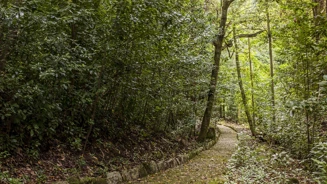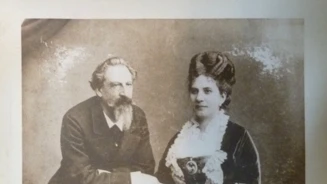Park of Pena, the most important arboretum in Portugal
22 May 2024
Getting lost in the Park of Pena may seem like a scary idea - it is actually comprised of 85 hectares - but it is, in fact, the best thing any visitor can do. There is a charm to be found around every corner, something to discover, a rare species, a flower of unparalleled beauty, a different aroma, an indescribable radiance. Everything in Pena Park is beautiful, the difficult part is managing to take in so much beauty at once.
A visitor might think that this area of Sintra was blessed with luck and that the most beautiful plants grew there by chance, as if attracted to each other. But no: it was the fruit of meticulous work by the creators of Pena, a man and a woman who saw the creation of this park as one of their missions in life.
A connoisseur of romantic aesthetics and exoticism, King Ferdinand II - the owner of the Park and Palace of Pena, properties purchased with his personal fortune after marrying Queen Maria II, combined these concepts with the wildness of the local nature and designed a large park, with specific places of interest (the High Cross, the Temple of Columns, St Catherine's Heights, the Queen's Fern Valley and the Countess' Fernery, all places of exceptional beauty).
Along the paths to these places, the king ordered the most varied species to be planted, coming from the four corners of the world. According to records that have survived to this day, King Ferdinand II planted hundreds of trees over the years - from ash, araucarias, walnut trees, pines, firs, fig trees, sour cherry trees, beeches, apple trees, oaks, etc. In 1841 alone, the Baron of Eschwege - the architect of the Palace of Pena - was responsible for planting “10 thousand weird trees”. This adjective clearly shows the sensation of strangeness that some species, coming from the other side of the world, could illicit. The volume of different species makes Pena Park the most significant arboretum in Portugal!

Some interesting facts about the Park of Pena
- Lemon was a great source of revenue! In 1862, the flow of lemon production was not operating as it should have been - “the Abelheira has never had as much lemon in it as it has this year and it is so much better” - and, therefore, “the king's secretary was very proactive to ensure that such a volume would not be wasted, and promoted sales that take into account the quality of the lemon”, reads the work D. Fernando II – Rei-Artista, Artista-Rei (King Ferdinand II - the Artist-King, King-Artist).
- King Ferdinand tried to create a big game reserve within the Park of Pena, “but the very rocky conditions of the Park itself and the difficulty guarding it posed major problems, to the point where several animals regularly turned up injured or dead. Displeased with the situation, King Ferdinand ordered the remaining animals to be transferred to Mafra in 1855: the stag, the two does, the fallow deer and the two fawns”, states the same book.
- Asian camellias, introduced to the Park of Pena by King Ferdinand II in the 1840s, became the signature of winters at Sintra, being the theme for balls and celebrations. There is even the Camellias Rally! The Garden of Camellias in the Park of Pena was distinguished as a Camellia Garden of Excellence in 2014 by the International Camellia Society.
- There is a tree within the Park that is known as ‘The Giant of Pena’. It is a 35 m tall Thuja plicata, with a notable characteristic: it appears to be walking! The explanation for this phenomenon can be found here.

The Countess and the Park
Elise Hensler, the Countess of Edla - the second wife of King Ferdinand II - played a pivotal role in this Pena reforestation project: “If it is true that it was King Ferdinand who began the process of afforestation at Pena, it is also true that, from the moment she started living with the king, at the start of the 1860s, it would be the Countess, twenty years younger than her husband, who would begin to direct much of this endeavour. She is responsible, among many other things, for the massive imports, through her family contacts in the United States, of exotic species from the American continent”, reads the book Os Criadores da Pena (The Creators of the Pena).
King Ferdinand and his wife spent long periods of time at the Chalet, built in the western part of the park. One of his favourite hobbies was seeing, in minute detail, how his project was flourishing. The king quickly realised that the Countess had a genuine passion for preserving all those species and this is very explicit in his last will and testament: “I ask my dearest wife to preserve, in my memory, the system of general plantation arrangement that has, until now, been followed and directed with so much intelligence and good taste, this system being the only one possible in these places to preserve that unique character that everyone recognises”.
The Countess took this mission seriously. In the correspondence she exchanged with Queen Amélia, the wife of King Carlos, after the death of King Ferdinand II, one can see the devotion with which she dedicated herself to the care of Pena Park: “(…) I was at Pena about three weeks ago (…) I hope that Her Majesty has seen the fern garden and agrees with the changes I made to it. I hope the weather improves so that I can go to the chalet for a few days,” she wrote. In 1904, at the age of 67, she shows that she continues to care for the park with all her love and affection: “I continue to carry out what I consider to be a sacred duty towards the memory of King Ferdinand and that is to take care of our beloved plants”.
